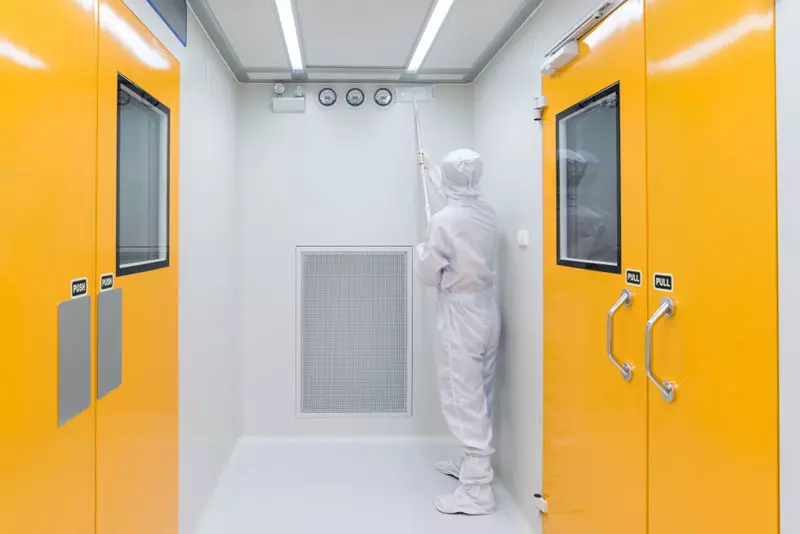


Cleanrooms are designed and built to provide a secure, contaminant-free environment for the safe manufacture, development, and packaging of a range of products. But any cleanroom is only as good as its contamination control policy.
If you’re looking for ways to ensure your cleanroom always meets its standards, these cleanroom contamination control tips can help.
Cleanroom contamination control is any measure a facility takes to reduce the contamination that’s introduced to a cleanroom environment, as well as to mitigate the effects of any existing contaminants within it.
Most cleanrooms are equipped with either HEPA or ULPA filters. These filters work to catch microscopic particles like bacteria, dust, and other pollutants as air is introduced to the cleanroom. They’re a big part of what makes a cleanroom different from a controlled environment.
However, air filtration systems alone aren’t enough to maintain safe operating conditions. This is why they’re combined with a variety of other contamination control efforts.
There are many sources of cleanroom contamination — from off-gassing equipment to everyday supplies like pens, wipes, and notebooks. But what’s the greatest source? People.
Why? We carry a ton of contaminant particles, of all kinds, on our bodies and clothing. Anything like skin cells, dandruff, cosmetics, perfumes, etc. can have an effect on a cleanroom’s safety and performance.
Also, upon entering or exiting a cleanroom, we leave the space vulnerable to infiltrating contaminants. That’s why it’s important to be extra cautious about and have a plan for process flow.
So what steps can you take to mitigate these contaminants risks, aside from installing a high-performance HEPA or ULPA filtration system? See below.
Your cleanroom should have clear guidelines for daily, weekly, and monthly deep cleaning procedures. This could include things like mopping floors, vacuuming walls, and sanitizing work areas. In most cases, it’s best to have just one employee responsible for daily cleanings, so as not to introduce more particles than necessary.
Specific cleaning protocols will likely vary depending on what ISO class your cleanroom must comply with. In order to create an effective cleaning protocol, make sure you’re familiar with what your cleanroom’s ISO classification is and what is required to meet it.
Whether it’s a daily, weekly, or monthly cleaning regimen, your employees should know to always clean the cleanroom from top to bottom. For instance, a logical order would be ceilings, walls, workstations, then floors. This ensures that all contaminant particles fall down to the floor where they can be swept up and safely removed.
Believe it or not, even cleaning products can be harmful to cleanrooms. If they’re not cleanroom-specified, they could introduce unwanted particles or corrode certain surfaces, introducing particles in a different manner.
So what can you use? Here’s a short list of some good options:
Since people are the greatest contributors to cleanroom contamination, it’s important that every employee who enters your cleanroom practices good hygiene, always. This means that they should wash their hands with a thorough, often documented, handwashing technique each time before they enter.
But good hygiene doesn’t stop at handwashing. It also includes maintaining clean hair and skin on all other parts of the body and not wearing any perfume, cologne, or cosmetics.
Many cleanroom protocols require employees to pass through an air shower before entering the cleanroom. Air showers generally supply ISO Class 5 filtered air that helps remove contaminant particles from the employee and their clothing. But as an extra precaution, cleanroom employees should also be well-equipped with personal protective equipment (PPE).
The type of PPE required often depends on your cleanroom application. For example, your employees may need a few basic items like lab coats, face masks, and gloves. Or, they may need even more protection from items like coveralls, goggles, bouffant caps, and foot coverings.
Whatever it may be, it’s important that your cleanroom employees know how to don and doff garbs properly. It’s also important to ensure the right PPE is always available and in plenty of supply.
No matter how comprehensive your cleaning protocol is, your cleanroom can only meet appropriate standards if it’s been built with the right materials and according to the right specifications. Starrco is proud to supply the precision-engineered materials you need to do so. For more information on how we can deliver a modular cleanroom that’s fit for your facility and application, contact our team online.